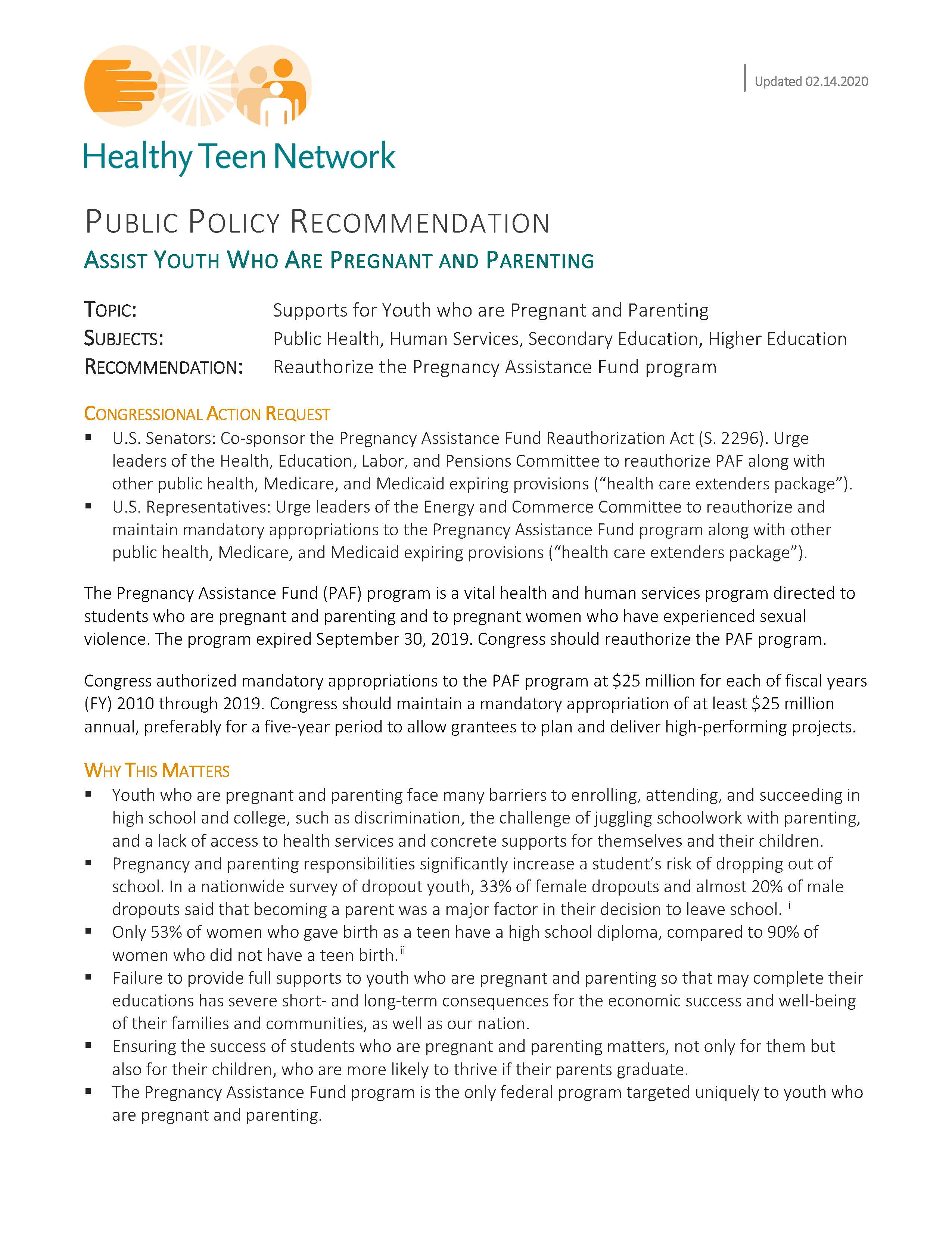Date: February 13, 2020

Topic
Supports for Youth who are Pregnant and Parenting
Subjects
Public Health, Human Services, Secondary Education, Higher Education
Recommendation
Reauthorize the Pregnancy Assistance Fund program
Congressional Action Request
- U.S. Senators: Co-sponsor the Pregnancy Assistance Fund Reauthorization Act (S. 2296). Urge leaders of the Health, Education, Labor, and Pensions Committee to reauthorize PAF along with other public health, Medicare, and Medicaid expiring provisions (“health care extenders package”).
- U.S. Representatives: Urge leaders of the Energy and Commerce Committee to reauthorize and maintain mandatory appropriations to the Pregnancy Assistance Fund program along with other public health, Medicare, and Medicaid expiring provisions (“health care extenders package”).
The Pregnancy Assistance Fund (PAF) program is a vital health and human services program directed to students who are pregnant and parenting and to pregnant women who have experienced sexual violence. The program expired September 30, 2019. Congress should reauthorize the PAF program.
Congress authorized mandatory appropriations to the PAF program at $25 million for each of fiscal years (FY) 2010 through 2019. Congress should maintain a mandatory appropriation of at least $25 million annual, preferably for a five-year period to allow grantees to plan and deliver high-performing projects.
Take Action Now
We invite organizations to join us in expressing support for the Pregnancy Assistance Fund. Organizations may review the sign-on letter and add their organization to the letter.
Why This Matters
- Youth who are pregnant and parenting face many barriers to enrolling, attending, and succeeding in high school and college, such as discrimination, the challenge of juggling schoolwork with parenting, and a lack of access to health services and concrete supports for themselves and their children.
- Pregnancy and parenting responsibilities significantly increase a student’s risk of dropping out of school. In a nationwide survey of dropout youth, 33% of female dropouts and almost 20% of male dropouts said that becoming a parent was a major factor in their decision to leave school. [i]
- Only 53% of women who gave birth as a teen have a high school diploma, compared to 90% of women who did not have a teen birth.[ii]
- Failure to provide full supports to youth who are pregnant and parenting so that may complete their educations has severe short- and long-term consequences for the economic success and well-being of their families and communities, as well as our nation.
- Ensuring the success of students who are pregnant and parenting matters, not only for them but also for their children, who are more likely to thrive if their parents graduate.
- The Pregnancy Assistance Fund program is the only federal program targeted uniquely to youth who are pregnant and parenting.
- Participants in State and Tribal PAF projects have experienced positive outcomes including improvements in high school graduation, acceptance into Institutions of Higher Education, reductions in dropping out of high school, and reductions in subsequent unintended pregnancies.[i]
- Compared to youth who are pregnant and parenting who did not receive services through the PAF program, program participants are more likely to graduate from high school (94% vs. 51%), less likely to drop out of high school (8% vs. 30%), and less likely to report a subsequent unintended pregnancy (6% vs. 20%).iii
Background
The Pregnancy Assistance Fund program is a competitive grant program that funds States and Tribal entities so they can provide a seamless network of support services to youth who are pregnant and parenting and/or pregnant women who experience sexual violence. States and Tribal entities receiving PAF grants then subaward their moneys to institutions of higher education, high schools, community services centers, State attorneys generals, or a combination thereof. These subgrantees use their PAF funds to establish, maintain, or operate health and human services support services for students who are pregnant and parenting, improve services for pregnant women who have experienced sexual violence, and increase public awareness and education concerning the services available to youth who are pregnant and parenting, pregnant women, fathers, and their families.
Participants in PAF projects receive a wide range of support services including services related to personal health (prenatal care, maternal wellness), child health (immunizations, well-child information), parenting supports, education support (tutoring, assistance working with teachers and school administrators when absent from school after birth of the baby), employment support (job training, interviewing skills) and concrete supports (diapers, food, baby equipment).
Congress first authorized and appropriated funds to the Pregnancy Assistance Fund in 2010.[i] Over the ten-year life of the program, over 94,000 youth who are pregnant and parenting and pregnant women in 32 States[ii] and 7 Tribal entities[iii] have benefited from the program. Currently, 22 States and 3 Tribal entities have active PAF grants, which conclude June 30, 2020.
Learn More
- U.S. Department of Health and Human Services, Pregnancy Assistance Fund
- U.S. Department of Health and Human Services, Performance Measures Snapshot: The Pregnancy Assistance Fund Program, Fiscal Year 2016
- Healthy Teen Network Position Statement. Educational Equity for Young People Who Are Pregnant or Parenting
[i] Public Law 111-148, 42 U.S.C. 18202-18204.
[ii] Alabama, Arizona, Arkansas, California, Connecticut, District of Columbia, Indiana, Iowa, Kansas, Maryland, Massachusetts, Michigan, Minnesota, Mississippi, Missouri, Montana, Nebraska, New Hampshire, New Jersey, New Mexico, New York, North Carolina, Oklahoma, Oregon, Pennsylvania, Rhode Island, South Carolina, Tennessee, Vermont, Virginia, Washington, Wisconsin (Italicized States have active grants)
[iii] Choctaw Tribe, Cook Inlet Tribal Council, Inc., Michigan Tribal Health, Pascua Yaqui Tribe, Riverside Tribe, Salish Tribe, Urban Indian Health Services (Italicized Tribal entities have active grants)
[i] About the Pregnancy Assistance Fund (PAF) Program. U.S. Health & Human Services, Office of Population Affairs. Retrieved from (U.S. Health and Human Services
[i] Bridgeland, J., Dilulio, J., Morison, K. (2006). The silent epidemic: Perspectives of high school dropouts. Bill & Melinda Gates Foundation. Retrieved from https://docs.gatesfoundation.org/documents/thesilentepidemic3-06final.pdf
[ii] Manlove, J., Lantos, H. (2018). Data point: Half of 20- to 29-year-old women who gave birth in their teens have a high school diploma. Washington, DC: Child Trends. Retrieved from https://www.childtrends.org/half-20-29-year-old-women-gave-birth-teens-high-school-diploma


